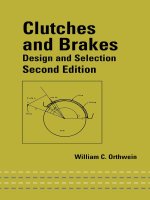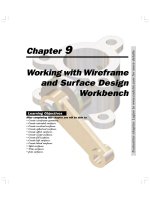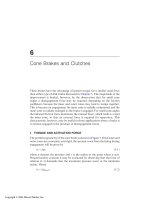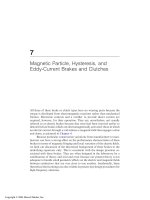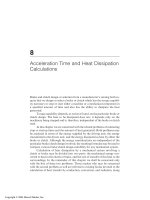Transformer and inductor design handbook ( TQL )
Bạn đang xem bản rút gọn của tài liệu. Xem và tải ngay bản đầy đủ của tài liệu tại đây (33.92 MB, 669 trang )
Transformer and Inductor
Design Handbook
Fourth Edition
© 2011 by Taylor and Francis Group, LLC
Transformer and Inductor
Design Handbook
Fourth Edition
Colonel Wm. T. McLyman
Boca Raton London New York
CRC Press is an imprint of the
Taylor & Francis Group, an informa business
© 2011 by Taylor and Francis Group, LLC
CRC Press
Taylor & Francis Group
6000 Broken Sound Parkway NW, Suite 300
Boca Raton, FL 33487-2742
© 2011 by Taylor and Francis Group, LLC
CRC Press is an imprint of Taylor & Francis Group, an Informa business
No claim to original U.S. Government works
Printed in the United States of America on acid-free paper
10 9 8 7 6 5 4 3 2 1
International Standard Book Number-13: 978-1-4398-3688-0 (Ebook-PDF)
This book contains information obtained from authentic and highly regarded sources. Reasonable efforts have been made to publish reliable data and
information, but the author and publisher cannot assume responsibility for the validity of all materials or the consequences of their use. The authors and
publishers have attempted to trace the copyright holders of all material reproduced in this publication and apologize to copyright holders if permission
to publish in this form has not been obtained. If any copyright material has not been acknowledged please write and let us know so we may rectify in any
future reprint.
Except as permitted under U.S. Copyright Law, no part of this book may be reprinted, reproduced, transmitted, or utilized in any form by any electronic,
mechanical, or other means, now known or hereafter invented, including photocopying, microfilming, and recording, or in any information storage or
retrieval system, without written permission from the publishers.
For permission to photocopy or use material electronically from this work, please access www.copyright.com ( or contact
the Copyright Clearance Center, Inc. (CCC), 222 Rosewood Drive, Danvers, MA 01923, 978-750-8400. CCC is a not-for-profit organization that provides
licenses and registration for a variety of users. For organizations that have been granted a photocopy license by the CCC, a separate system of payment
has been arranged.
Trademark Notice: Product or corporate names may be trademarks or registered trademarks, and are used only for identification and explanation
without intent to infringe.
Visit the Taylor & Francis Web site at
and the CRC Press Web site at
© 2011 by Taylor and Francis Group, LLC
To My Wife, Bonnie
© 2011 by Taylor and Francis Group, LLC
Contents
Foreword ix
Preface xi
Acknowledgements xiii
About the Author xv
Symbols xvii
Chapter 1
Fundamentals of Magnetics..............................................................................................................................1-1
Chapter 2
Magnetic Materials and Their Characteristics.................................................................................................2-1
Chapter 3
Magnetic Cores.................................................................................................................................................3-1
Chapter 4
Window Utilization, Magnet Wire, and Insulation..........................................................................................4-1
Chapter 5
Transformer Design Trade-Offs.......................................................................................................................5-1
Chapter 6
Transformer-Inductor Efficiency, Regulation, and Temperature Rise..............................................................6-1
Chapter 7
Power Transformer Design...............................................................................................................................7-1
Chapter 8
DC Inductor Design, Using Gapped Cores.......................................................................................................8-1
Chapter 9
DC Inductor Design, Using Powder Cores.......................................................................................................9-1
Chapter 10
AC Inductor Design........................................................................................................................................10-1
Chapter 11
Constant Voltage Transformer (CVT)............................................................................................................ 11-1
Chapter 12
Three-Phase Transformer Design...................................................................................................................12-1
vii
© 2011 by Taylor and Francis Group, LLC
Contents
viii
Chapter 13
Flyback Converters, Transformer Design.......................................................................................................13-1
Chapter 14
Forward Converter, Transformer Design, and Output Inductor Design.........................................................14-1
Chapter 15
Input Filter Design..........................................................................................................................................15-1
Chapter 16
Current Transformer Design...........................................................................................................................16-1
Chapter 17
Winding Capacitance and Leakage Inductance............................................................................................. 17-1
Chapter 18
Quiet Converter Design..................................................................................................................................18-1
Chapter 19
Rotary Transformer Design............................................................................................................................19-1
Chapter 20
Planar Transformers and Inductors................................................................................................................ 20-1
Chapter 21
Derivations for the Design Equations............................................................................................................. 21-1
Chapter 22
Autotransformer Design.................................................................................................................................22-1
Chapter 23
Common-Mode Inductor Design....................................................................................................................23-1
Chapter 24
Series Saturable Reactor Design.................................................................................................................... 24-1
Chapter 25
Self-Saturating, Magnetic Amplifiers.............................................................................................................25-1
Chapter 26
Designing Inductors for a Given Resistance.................................................................................................. 26-1
Index I-1
© 2011 by Taylor and Francis Group, LLC
Foreword
Colonel McLyman is a well-known author, lecturer and magnetic circuit designer. His previous books on
transformer and inductor design, magnetic core characteristics and design methods for converter circuits have
been widely used by magnetics circuit designers.
In his 4th edition, Colonel McLyman has combined and updated the information found in his previous books.
He has also added five new subjects such as autotransformer design, common-mode inductor design, series
saturable reactor design, self-saturating magnetic amplifier and designing inductors for a given resistance. The
author covers magnetic design theory with all of the relevant formulas. He has complete information on all of
the magnetic materials and core characteristics along with the real world, step-by-step design examples.
This book is a must for engineers doing magnetic design. Whether you are working on high “rel” state of the
art design or high volume, or low cost production, this book will help you. Thanks Colonel for a well-done,
useful book.
Robert G. Noah
Application Engineering Manager (Retired)
Magnetics, Division of Spang and Company
Pittsburgh, Pennsylvania
ix
© 2011 by Taylor and Francis Group, LLC
Preface
I have had many requests to update my book Transformer and Inductor Design Handbook, because of the way
power electronics has changed in the past few years. I have been requested to add and expand on the present
Chapters. There are now twenty-six Chapters. The new Chapters are autotransformer design, common-mode
inductor design, series saturable reactor design, self-saturating magnetic amplifier and designing inductors for
a given resistance, all with step-by-step design examples.
This book offers a practical approach with design examples for design engineers and system engineers in the
electronics industry, as well as the aerospace industry. While there are other books available on electronic
transformers, none of them seem to have been written with the user’s viewpoint in mind. The material in this
book is organized so that the design engineer, student engineer or technician, starting at the beginning of the
book and continuing through the end, will gain a comprehensive knowledge of the state of the art in transformer and inductor design. The more experienced engineers and system engineers will find this book a useful
tool when designing or evaluating transformers and inductors.
Transformers are to be found in virtually all electronic circuits. This book can easily be used to design lightweight, high-frequency aerospace transformers or low-frequency commercial transformers. It is, therefore,
a design manual.
The conversion process in power electronics requires the use of transformers, components that frequently are
the heaviest and bulkiest item in the conversion circuit. Transformer components also have a significant effect
on the overall performance and efficiency of the system. Accordingly, the design of such transformers has an
important influence on overall system weight, power conversion efficiency, and cost. Because of the interdependence and interaction of these parameters, judicious trade-offs are necessary to achieve design optimization.
Manufacturers have for years assigned numeric codes to their cores to indicate their power-handling ability.
This method assigns to each core a number called the area product, Ap, that is the product of its window area,
Wa, and core cross-section area, Ac. These numbers are used by core suppliers to summarize dimensional and
electrical properties in their catalogs. The product of the window area, Wa, and the core area, Ac, gives the area
product, Ap, a dimension to the fourth power. I have developed a new equation for the power-handling ability
of the core, the core geometry, Kg. The core geometry, Kg, has a dimension to the fifth power. This new equation gives engineers faster and tighter control of their design. The core geometry coefficient, Kg, is a relatively
new concept, and magnetic core manufacturers are now beginning to put it in their catalogs.
Because of their significance, the area product, Ap, and the core geometry, Kg, are treated extensively in this
handbook. A great deal of other information is also presented for the convenience of the designer. Much of the
material is in tabular form to assist the designer in making the trade-offs best suited for the particular application in a minimum amount of time.
xi
© 2011 by Taylor and Francis Group, LLC
xii
Preface
Designers have used various approaches in arriving at suitable transformer and inductor designs. For example,
in many cases a rule of thumb used for dealing with current density is that a good working level is 1000 circular mils per ampere. This is satisfactory in many instances; however, the wire size used to meet this requirement may produce a heavier and bulkier inductor than desired or required. The information presented here
will make it possible to avoid the use of this and other rules of thumb, and to develop a more economical and
better design.
The author or the publisher assumes no responsibility for any infringement of patent or other rights of third
parties that may result from the use of circuits, systems, or processes described or referred to in this handbook.
I wish to thank the manufacturers represented in this book for their assistance in supplying technical data.
Colonel Wm. T. McLyman
© 2011 by Taylor and Francis Group, LLC
Acknowledgements
In gathering the material for this book, I have been fortunate in having the assistance and cooperation of several
companies and many colleagues. As the author, I wish to express my gratitude to all of them. The list is too
long to mention them all. However, there are some individuals and companies whose contributions have been
significant. Colleagues that have retired from Magnetics include Robert Noah and Harry Savisky who helped
so greatly with the editing of the final draft. Other contributions were given by my colleagues at Magnetics,
Lowell Bosley and his staff with the sending of up-to-date catalogs and sample cores. I would like to thank
colleagues at Micrometals Corp., Jim Cox and Dale Nicol, and George Orenchak of TSC International. I would
like to give a special thanks to Richard (Oz) Ozenbaugh of Linear Magnetics Corp. for his assistance in the
detailed derivations of many of the equations and his efforts in checking all the design examples. I would
also like to give special thanks to Steve Freeman of Rodon Products, Inc. and Charles Barnett of Leightner
Electronics, Inc. for building and testing all of the magnetic components used in the design examples.
There are individuals I would like to thank: Dr. Vatche Vorperian of Jet Propulsion Laboratory (JPL) for his
help in generating and clarifying equations for the Quiet Converter; Jerry Fridenberg of Fridenberg Research,
Inc. for modeling circuits on his SPICE program; Dr. Gene Wester of (JPL) for his inputs and Kit Sum for his
assistance in the energy storage equations. I also want to thank the late Robert Yahiro for his help and encouragement over the years.
xiii
© 2011 by Taylor and Francis Group, LLC
About The Author
Colonel Wm. T. McLyman has retired as a senior member of the Avionics Equipment Section of the Jet
Propulsion Laboratory (JPL) affiliated with the California Institute of Technology in Pasadena, California. He
has fifty-four years of experience in the field of Magnetics and holds fourteen United States Patents on magnetics-related concepts. Through his thirty years at JPL, he has written over seventy JPL technical memorandums,
new technology reports, and tech-briefs on the subject of magnetics and circuit designs for power conversion.
He has worked on projects for NASA including the Pathfinder Mission to Mars, Cassini, Galileo, Magellan,
Viking, Voyager, MVM, Hubble Space Telescope, and many others.
He has been on the lecture circuit for over twenty-nine years speaking in the United States, Canada, Mexico,
and Europe on the design and fabrication of magnetic components. He is known as a recognized authority in
magnetic design. He is the president of his company called Kg Magnetics, Inc., which specializes in power
magnetics design.
He has also written a book entitled Design and Fabrication of High Reliability Magnetic Devices. This book
is based on fabricating and testing Hi-Rel magnetic devices. He also markets through Kg Magnetics, Inc. a
magnetics design and analysis software computer program called “Titan” for transformers and inductors, see
Figure 1. This program operates on Windows 95, 98, 2000, and NT.
Figure 1. Computer Design Program Main Menu.
Kg Magnetics, Inc.
Colonel Wm. T. McLyman, (President)
www.kgmagnetics.com
Idyllwild, CA 92549
xv
© 2011 by Taylor and Francis Group, LLC
Symbols
α
regulation, %
Ac
effective cross section of the core, cm2
Ap
area product, cm4
At
surface area of the transformer, cm2
Aw
wire area, cm2
Aw(B)
bare wire area, cm2
Aw(I)
insulated wire area, cm2
Awp
primary wire area, cm2
Aws
secondary wire area, cm2
A-T
amp turn
AWG
American wire gage
B
flux, teslas
Bac
alternating current flux density, teslas
ΔB
change in flux, teslas
Bdc
direct current flux density, teslas
Bm
flux density, teslas
Bmax
maximum flux density, teslas
Bo
operating peak flux density, teslas
Bpk
peak flux density, teslas
Br
residual flux density, teslas
Bs
saturation flux density, teslas
C
capacitance
Cn
new capacitance
Cp
lumped capacitance
Cs
stray capacitance
CM
circular mils
CM
common mode
DAWG
wire diameter, cm
D(min)
minimum duty ratio
D(max)
maximum duty ratio
Dw
dwell time duty ratio
DM
differential mode
E
voltage
ELine
line-to-line voltage
EPhase
Line to neutral voltage
Energy energy, watt-second
ESR
equivalent series resistance
xvii
© 2011 by Taylor and Francis Group, LLC
Symbols
xviii
η
efficiency
f
frequency, Hz
F
fringing flux factor
Fm
magneto-motive force, mmf
F.L.
full load
G
winding length, cm
γ
density, in grams-per-cm2
ε
skin depth, cm
H
magnetizing force, oersteds
H
magnetizing force, amp-turns
Hc
magnetizing force required to return flux to zero, oersteds
ΔH
delta magnetizing force, oersteds
Ho
operating peak magnetizing force
Hs
magnetizing force at saturation, oersteds
I
current, amps
Ic
charge current, amps
Ic
control current, amps
ΔI
delta current, amps
Idc
dc current, amps
Ig
gate current, amps
Iin
input current, amps
ILine
input line current, amps
Im
magnetizing current, amps
Io
load current, amps
Io(max)
maximum load current, amps
Io(min)
minimum load current, amps
Ip
primary current, amps
IPhase
input phase current, amps
Is
secondary current, amps
Is(Phase) secondary phase current, amps
Is(Line)
secondary line current, amps
J
current density, amps per cm2
Kc
copper loss constant
Kc
quasi-voltage waveform factor
Ke
electrical coefficient
Kcw
control winding coefficient
K f
waveform coefficient
© 2011 by Taylor and Francis Group, LLC
Symbols
Kg
core geometry coefficient, cm5
Kj
constant related to current density
K s
constant related to surface area
Ku
window utilization factor
Kup
primary window utilization factor
Kus
secondary window utilization factor
Kvol
constant related to volume
Kw
constant related to weight
L
inductance, henry
l
is a linear dimension
λ
density, grams per cm3
Lc
open circuit inductance, henrys
Lc
control winding inductance, henrys
L(crt)
critical inductance
lg
gap, cm
lm
magnetic path length, cm
Lp
primary inductance, henrys
lt
total path length, cm
MA
magnetic amplifier
mks
meters-kilogram-seconds
MLT
mean length turn, cm
mmf
magnetomotive force, Fm
MPL
magnetic path length, cm
mW/g
milliwatts-per-gram
μ
permeability
μe
effective permeability
μi
initial permeability
μ Δ
incremental permeability
μm
core material permeability
μo
permeability of air
μ r
relative permeability
n
turns ratio
N
turns
Nc
control turns
Ng
gate turns
NL
inductor turns
Nn
new turns
© 2011 by Taylor and Francis Group, LLC
xix
Symbols
xx
Np
primary turns
Ns
secondary turns
N.L.
no load
P
watts
Pc
control power loss, watts
Pcu
copper loss, watts
Pfe
core loss, watts
Pg
gap loss, watts
Pgain
power gain, factor
ϕ
magnetic flux
Pin
input power, watts
PL
inductor copper loss, watts
Po
output power, watts
Pp
primary copper loss, watts
Ps
secondary copper loss, watts
PΣ
total loss (core and copper), watts
Pt
total apparent power, watts
Ptin
autotransformer input power, volt-amps
Pto
autotransformer output power, volt-amps
PVA
primary, volt-amps
R
resistance, ohms
Rac
ac resistance, ohms
Rc
control resistance, ohms
Rcu
copper resistance, ohms
Rdc
dc resistance, ohms
Re
equivalent core loss (shunt) resistance, ohms
Rg
reluctance of the gap
Rin(equiv) reflected load resistance, ohms
R L
load resistance, ohms
Rm
reluctance
Rmt
total reluctance
Ro
load resistance, ohms
Ro(R)
reflected load resistance, ohms
Rp
primary resistance, ohms
RR
ac/dc resistance ratio
Rs
secondary resistance, ohms
Rt
total resistance, ohms
© 2011 by Taylor and Francis Group, LLC
Symbols
ρ
resistivity, ohm-cm
S1
conductor area/wire area
S2
wound area/usable window
S3
usable window area/window area
S4
usable window area/usable window area + insulation area
Snp
number of primary strands
Sns
number of secondary strands
SVA
secondary volt-amps
SR
saturable reactor
T
total period, seconds
toff
off time, seconds
ton
on time, seconds
t r
time constant, seconds
Tr
temperature rise, degrees C
tw
dwell time, seconds
U
multiplication factor
Vac
applied voltage, volts
Vc
control voltage, volts
Vc(pk)
peak voltage, volts
Vd
diode voltage drop, volts
Vin
input voltage, volts
Vin(max) maximum input voltage, volts
Vin(min) minimum input voltage, volts
Vn
new voltage, volts
Vo
output voltage, volts
Vp
primary voltage, volts
Vp(rms)
primary rms voltage, volts
Vr(pk)
peak ripple voltage
Vs(LL)
secondary line-to-line voltage, volts
Vs(LN)
secondary line to neutral voltage, volts
Vs
secondary voltage, volts
ΔVCC
capacitor voltage, volts
ΔVCR
capacitor ESR voltage, volts
ΔVp
delta primary voltage, volts
ΔVs
delta secondary voltage, volts
VA
volt-amps
W
watts
© 2011 by Taylor and Francis Group, LLC
xxi
Symbols
xxii
W/kg
watts-per-kilogram
WK
watts-per-kilogram
Wa
window area, cm2
Wac
control window area, cm2
Wa(eff)
effective window area, cm2
Wag
gate window area, cm2
Wap
primary window area, cm2
Was
secondary window area, cm2
Wt
weight, grams
Wtcu
copper weight, grams
Wtfe
iron weight, grams
w-s
watt-seconds
XL
inductive reactance, ohms
© 2011 by Taylor and Francis Group, LLC
Chapter 9
DC Inductor Design, Using Powder Cores
9-1
© 2011 by Taylor and Francis Group, LLC
9-2
DC Inductor Design, Using Powder Cores
Table of Contents
1. Introduction............................................................................................................................................9-3
2. Molybdenum Permalloy Powder Cores (MPP)...................................................................................9-3
3. High Flux Powder Cores (HF)..............................................................................................................9-3
4. Sendust Powder Cores (Magnetics Kool Mμ).....................................................................................9-4
5. Iron Powder Cores.................................................................................................................................9-4
6. Inductors.................................................................................................................................................9-5
7. Relationship of, Ap, to Inductor’s Energy-Handling Capability.......................................................9-5
8. Relationship of, Kg, to Inductor’s Energy-Handling Capability.......................................................9-6
9. Fundamental Considerations...............................................................................................................9-7
10. Toroidal Powder Core Design Using the Core Geometry, Kg, Approach.........................................9-9
11. Toroidal Powder Core Inductor Design, Using the Area Product, Ap, Approach...........................9-15
© 2011 by Taylor and Francis Group, LLC
High Flux Powder Cores (HF)
9-3
Introduction
Powder cores are manufactured from very fine particles of magnetic materials. The powder is coated
with an inert insulation to minimize eddy current losses and to introduce a distributed air gap into the
core structure. The insulated powder is then compacted into toroidal and EE cores. The magnetic flux in
a toroidal powder core can be contained inside the core more readily than in a lamination or C core, as
the winding covers the core along the entire Magnetic Path Length. The design of an inductor also frequently involves consideration of the effect of its magnetic field on devices near where it is placed. This
is especially true in the design of high-current inductors for converters and switching regulators used in
spacecraft.
Toroidal powder cores are widely used in high-reliability military and space applications because of their
good stability over wide temperature ranges, and their ability to withstand high levels of shock, vibration, and
nuclear radiation without degradation. Other applications for these cores are:
1. Stable, high-Q filters operating in the frequency range of 1kHz to 1MHz.
2.Loading coils used to cancel out the distributed capacitance in telephone cables.
3.Pulse transformers.
4.Differential mode EMI noise filters.
5.Flyback transformers.
6.Energy storage, or output inductors, in circuits with large amounts of dc current flowing.
Molybdenum Permalloy Powder Cores (MPP)
Molybdenum Permalloy Powder Cores (MPP) are manufactured from very fine particles of an 81% nickel,
17% iron, and a 2% molybdenum alloy. The insulated powder is then compacted into, EE, and toroidal cores.
The toroidal cores range in size from 0.1 inch (0.254 cm) to 5 inches (12.7 cm) in the outside diameter. MPP
cores are available in permeabilities ranging from 14 up to 550. See Table 9-1.
High Flux Powder Cores (HF)
High Flux Powder Cores (HF) are manufactured from very fine particles of a 50% nickel, and 50% iron. The
insulated powder is then compacted into, EE, and toroidal cores. The toroidal cores range in size from 0.25 inch
(0.635 cm) to 3 inches (7.62 cm) in the outside diameter. HF cores are available in permeabilities ranging from
14 up to 160. See Table 9-1.
© 2011 by Taylor and Francis Group, LLC
DC Inductor Design, Using Powder Cores
9-4
Sendust Powder Cores (Magnetics Kool Mμ)
Sendust powder cores are manufactured from very fine particles of an 85% iron, 9% silicon, and 6% aluminum. The insulated powder is then compacted into EE and toroidal cores. The toroidal cores range in size from
0.14 inch (0.35 cm) to 3 inches (7.62 cm) in the outside diameter. Sendust cores are available in permeabilities
ranging from 26 up to 125. See Table 9-1.
Iron Powder Cores
The low cost iron powder cores are typically used in today’s low and high frequency power switching conversion applications for differential-mode, input and output, power inductors. The distributed air gap characteristic of iron powder produces a core with permeability ranging from 10 to 100. This feature, in conjunction with
the inherent high saturation point of iron, makes it very difficult to saturate. While iron powder cores may be
limited in their use because of low permeability, or rather high core loss at high frequency, they have become
a very popular choice in either, EE, or toroidal as a core material for high-volume commercial applications.
They are popular due to their low cost compared with other core materials. The toroidal cores range in size
from 0.3 inch (0.76 cm) to 6.5 inches (16.5 cm) in the outside diameter. See Table 9-1.
Table 9-1. Standard Powder Core Permeability
Standard Powder Core Permeabilities
Powder Material
MPP
High Flux
14
X
X
26
X
X
Sendust
(Kool Mμ)
Iron Powder
Initial Permeability, μi
10
X
X
35
X
40
X
55
60
X
X
X
X
X
75
X
X
90
X
100
X
125
X
X
147
X
X
160
X
X
173
X
200
X
300
X
550
X
© 2011 by Taylor and Francis Group, LLC
X
Relationship of, Ap , to Inductor’s Energy-Handling Capability
9-5
Inductors
Inductors that carry direct current are used frequently in a wide variety of ground, air, and space applications. Selection of the best magnetic core for an inductor frequently involves a trial-and-error type of
calculation.
The design of an inductor also frequently involves consideration of the effect of its magnetic field on other
devices in the immediate vicinity. This is especially true in the design of high-current inductors for converters
and switching regulators used in spacecraft, which may also employ sensitive magnetic field detectors. For this
type of design problem, it is frequently imperative that a toroidal core be used. The magnetic flux in a powder core can be contained inside the core more readily than in a lamination or C core, as the winding covers
the core along the entire Magnetic Path Length. The author has developed a simplified method of designing
optimum, dc carrying inductors with powder cores. This method allows the correct core permeability to be
determined without relying on the trial and error method.
Relationship of, Ap, to Inductor’s Energy-Handling Capability
The energy-handling capability of a core is related to its area product, Ap, by the Equation:
Ap =
( ),
2 ( Energy ) 10 4
Bm J K u
[cm 4 ]
[9-1]
Where: Energy is in watt-seconds.
Bm is the flux density, teslas.
J is the current density, amps-per-cm2.
Ku is the window utilization factor. (See Chapter 4)
From the above factors, such as flux density, Bm, window utilization factor, Ku, (which defines the maximum
space that may be used by the copper in the window), and the current density, J, which controls the copper loss
can be seen. The energy-handling capability of a core is derived from:
© 2011 by Taylor and Francis Group, LLC
Energy =
LI2
, [watt-seconds]
2
[9-2]
DC Inductor Design, Using Powder Cores
9-6
Relationship of, Kg, to Inductor’s Energy-Handling Capability
Inductors, like transformers, are designed for a given temperature rise. They can also be designed for a given
regulation. The regulation and energy handling ability of a core is related to two constants:
2
Energy )
(
α=
,
[%]
[9-3]
Wa Ac2 K u
, [cm 5 ]
MLT
[9-4]
K g Ke
Where, α, is the regulation in, %.
The constant, Kg, is determined by the core geometry:
Kg =
The constant, Ke, is determined by the magnetic and electrical operating conditions:
(
)
K e = 0.145 Po Bm2 10 −4
[9-5]
The output power, Po, is defined in Figure 9-1.
Po( L1) = V( 01) I( 01)
+
L1
Iin
CR1
Vin
[9-6]
L2
Q1
I(01)
V(01)
Po( L 2) = V( 02) I( 02)
I(02)
CR2
C1
+
V(02)
Io
C2 +
+
Vo
−
−
Figure 9-1. Defining the Inductor Output Power.
The operating flux density, Bm, is:
Bm = Bdc +
Bac
, [teslas]
2
From the above, it can be seen that the flux density, Bm, is the predominant factor in governing size.
© 2011 by Taylor and Francis Group, LLC
[9-7]
Fundamental Considerations
9-7
Fundamental Considerations
The design of a linear reactor depends upon four related factors:
1. Desired inductance, L.
2.Direct current, Idc.
3.Alternating current, ΔI.
4.Power loss and temperature, Tr.
With these requirements established, the designer must determine the maximum values for, Bdc, and Bac, that
will not produce magnetic saturation and must make trade-offs that will yield the highest inductance for a
given volume. The core permeability chosen dictates the maximum dc flux density that can be tolerated for a
given design.
If an inductance is to be constant with the increasing direct current, there must be a negligible drop in inductance over the operating current range. The maximum, H, (magnetizing force) then is an indication of a core’s
capability, as shown in Figure 9-2.
100
Powder Cores
Percent of Initial Permeability
80
60
Low Permeability
High Permeability
40
20
0
1.0
10
100
1000
DC Magnetizing Force (oersteds)
Figure 9-2. Typical Permeability Versus dc Bias Curves for Powder Cores.
Most manufacturers give the dc magnetizing force, H in oersteds:
© 2011 by Taylor and Francis Group, LLC
H=
0.4 π N I
, [oersteds]
MPL
[9-8]
DC Inductor Design, Using Powder Cores
9-8
Some engineers prefer amp-turns:
N I = 0.8 H ( MPL ) , [amp-turns]
[9-9]
Inductance decreases with increasing flux density, B, and magnetizing force, H, for various materials of
different values of permeability. The selection of the correct permeability for a given design is made using
Equation [9-10].
µ∆ =
( )
Bm ( MPL ) 10 4
[9-10]
0.4 πWa J K u
It should be remembered that the maximum flux, Bm, depends upon, Bdc + Bac, in the manner shown in
Figure 9-3.
Bm = Bdc +
Bdc =
Bac
, [teslas]
2
(
0.4 π N I dc µ 10 −4
MPL
),
[9-11]
[teslas]
∆I
0.4 π N µ 10 −4
2
, [teslas]
Bac =
MPL
(
Bpk
)
∆I
0.4 π N I dc + µ 10 −4
2
, [teslas]]
=
MPL
(
)
B (teslas)
ΔI
ΔB
Bdc
−H
H (oersteds)
Idc
−B
Figure 9-3. Inductor Flux Density Versus, Idc + ΔΙ Current.
© 2011 by Taylor and Francis Group, LLC
[9-12]
[9-13]
[9-14]
